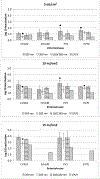Efficacy of inactivation of human enteroviruses by dual-wavelength germicidal ultraviolet (UV-C) light emitting diodes (LEDs)
- PMID: 31275622
- PMCID: PMC6604855
- DOI: 10.3390/w11061131
Efficacy of inactivation of human enteroviruses by dual-wavelength germicidal ultraviolet (UV-C) light emitting diodes (LEDs)
Abstract
The efficacy of germicidal ultraviolet (UV-C) light emitting diodes (LEDs) was evaluated for inactivating human enteroviruses included on the United States Environmental Protection Agency (EPA)'s Contaminant Candidate List (CCL). A UV-C LED device, emitting at peaks of 260 nm and 280 nm and the combination of 260∣280 nm together, was used to measure and compare potential synergistic effects of dual wavelengths for disinfecting viral organisms. The 260 nm LED proved to be the most effective at inactivating the CCL enteroviruses tested. To obtain 2-log10 inactivation credit for the 260 nm LED, the fluences (UV doses) required are approximately 8 mJ/cm2 for coxsackievirus A10 and poliovirus 1, 10 mJ/cm2 for enterovirus 70, and 13 mJ/cm2 for echovirus 30. No synergistic effect was detected when evaluating the log inactivation of enteroviruses irradiated by the dual-wavelength UV-C LEDs.
Keywords: UV-C LEDs; dual-wavelength; human enteroviruses; synergy; ultraviolet disinfection; viral inactivation efficacy.
Conflict of interest statement
Conflicts of Interest: The authors declare no conflict of interest.
Figures


Similar articles
-
Inactivation Kinetics of Alicyclobacillus acidoterrestris Spores and Determination of Spore Germicidal Fluences Under UV-C Treatment.J Food Prot. 2025 Mar 24;88(4):100473. doi: 10.1016/j.jfp.2025.100473. Epub 2025 Feb 27. J Food Prot. 2025. PMID: 40023402
-
Evaluating UV-C LED disinfection performance and investigating potential dual-wavelength synergy.Water Res. 2017 Feb 1;109:207-216. doi: 10.1016/j.watres.2016.11.024. Epub 2016 Nov 7. Water Res. 2017. PMID: 27889622 Free PMC article.
-
Wavelength-Dependent Damage to Adenoviral Proteins Across the Germicidal UV Spectrum.Environ Sci Technol. 2018 Jan 2;52(1):223-229. doi: 10.1021/acs.est.7b04602. Epub 2017 Dec 20. Environ Sci Technol. 2018. PMID: 29261289
-
Evaluation survey of microbial disinfection methods in UV-LED water treatment systems.Sci Total Environ. 2019 Apr 1;659:1415-1427. doi: 10.1016/j.scitotenv.2018.12.344. Epub 2018 Dec 24. Sci Total Environ. 2019. PMID: 31096352 Review.
-
Considerations for determining the performance of ultraviolet light emitting diode fluid disinfection systems.Water Environ Res. 2023 Nov;95(11):e10947. doi: 10.1002/wer.10947. Water Environ Res. 2023. PMID: 38014702 Review.
Cited by
-
Wavelength synergistic effects in continuous flow-through water disinfection systems.Water Res X. 2023 Nov 19;21:100208. doi: 10.1016/j.wroa.2023.100208. eCollection 2023 Dec 1. Water Res X. 2023. PMID: 38098879 Free PMC article.
-
Sensitivity of Bacteria, Protozoa, Viruses, and Other Microorganisms to Ultraviolet Radiation.J Res Natl Inst Stand Technol. 2021 Aug 20;126:126021. doi: 10.6028/jres.126.021. eCollection 2021. J Res Natl Inst Stand Technol. 2021. PMID: 39081635 Free PMC article.
-
Roles and Knowledge Gaps of Point-of-Use Technologies for Mitigating Health Risks from Disinfection Byproducts in Tap Water: A Critical Review.Water Res. 2021 Jul 15;200:117265. doi: 10.1016/j.watres.2021.117265. Epub 2021 May 18. Water Res. 2021. PMID: 34091221 Free PMC article. Review.
-
UV-C Light: A Promising Preservation Technology for Vegetable-Based Nonsolid Food Products.Foods. 2023 Aug 27;12(17):3227. doi: 10.3390/foods12173227. Foods. 2023. PMID: 37685160 Free PMC article. Review.
-
Systematic evaluating and modeling of SARS-CoV-2 UVC disinfection.Sci Rep. 2022 Apr 7;12(1):5869. doi: 10.1038/s41598-022-09930-2. Sci Rep. 2022. PMID: 35393480 Free PMC article.
References
-
- Greninger AL, Naccache SN, Messacar K, Clayton A, Yu G, Somasekar S, Federman S, Stryke D, Anderson C, Yagi S, Messenger S, Wadford D, Xia D, Watt JP, Van Haren K, Dominguez SR, Glaser C, Aldrovandi G, and Chiu CY. 2015. A novel outbreak enterovirus D68 strain associated with acute flaccid myelitis cases in the USA (2012–14): a retrospective cohort study. Lancet Infect. Dis. 15:671–682. - PMC - PubMed
-
- Khan F 2015. Enterovirus D68: acute respiratory illness and the 2014 outbreak. Emergency Medicine Clinucs of North America 33:e19–e32. - PubMed
-
- Centers for Disease Control and Prevention. Non-Polio Enterovirus [Internet]. 2018. [updated November 2018]. Available from: https://www.cdc.gov/non-polio-enterovirus/index.html.
-
- Centers for Disease Control and Prevention. Global health—global disease detection and emergency response [Internet]. 2012. [updated June 2012]. Available from: https://www.cdc.gov/globalhealth/healthprotection/gdd/resources/factshee....
Grants and funding
LinkOut - more resources
Full Text Sources
Other Literature Sources
Research Materials
